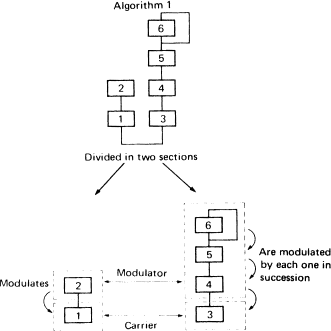 |
| FM TONE GENERATION |
 |
FM Tone Generation . . . . Understanding the Basics
The DX7 is an entirely new type of synthesizer employing an entirely new FM digital tone generation system. This unique Yamaha system permits finer control over subtle musical nuances and vastly expanded voice creation potential compared to conventional synthesizers.
- The Meaning of FM
FM stands for Frequency modulation. FM radio broadcasts use the same principle. One signal--the modulator--modulates a second signal--the carrier.
In FM radio the carrier is an extremely high "ratio" frequency and the modulator is the music signal to be broadcast. In effect, the carrier "carries" the modulator signal through the atmosphere to your receiving antenna.
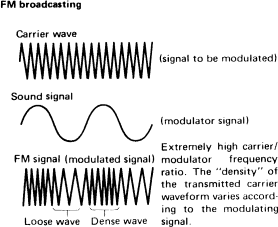
The FM tone generator system is similar in principle, but in this case both the carrier and modulator are audible signals, and their frequencies can be almost equal.
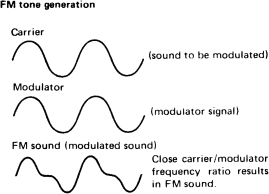
- FM Tone Generation in the DX7
In the DX7, the carrier signal determines the pitch of the note produced and modulator determines the shape of the waveform produced and therefore its timbre. This explanation may make it look like the carrier and the modulator are two entirely separate things. In fact, they are one and the same. A special oscillator unit called an "operator" can be used as either a carrier or modulator in the DX7.
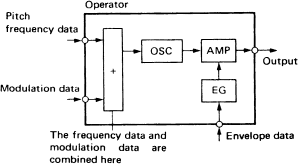
- Pitch Frequency Data
Pitch Frequency data from the DX7's microcomputer system determines the operator's oscillation frequency. When the operator is used as a carrier, this frequency is equivalent to the pitch of the note produced. When the operator is being used as a modulator, the ratio of its frequency to that of the carrier determines the timbre of the note produced.
- Modulation Data
This is the modulation data received from the previous operator's (modulator) output.
- Envelope Data
When the operator is used as a carrier the envelope data determines the volume envelope of the note produced. When the operator is used as a modulator the envelope data determines the timbre envelope of the note produced.
For example, the pitch frequency data applied to an operator used as a carrier determines the frequency of the sine wave output from the operator. Inputting envelope data results in an output waveform similar to that shown in the figure.
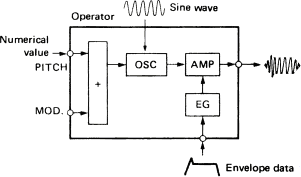
- Relationship of Carrier to Modulator
An operator can be used as either a carrier or modulator. These two basic operator functions are the basis for the FM tone generation system. Two operators can be combined in two different ways.
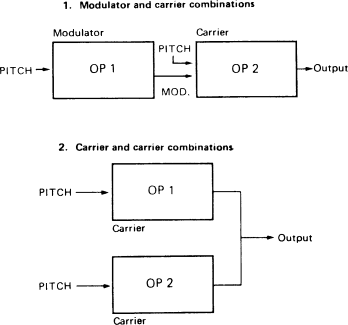
- Carrier and Carrier
This configuration results in a pure sine wave output from both operators. The combination of these waveforms can sound much like a conventional organ.
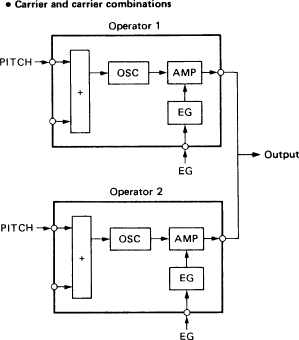
- Modulator and Carrier
In the modulator/carrier configuration using two operators, shown in the figure, the operator on the left is the modulator and the operator on the right is the carrier. In the FM system, the last operator in a chain of two or more operators is the carrier. By varying the ratio of the modulator and carrier frequencies, and by varying the envelope of the modulator, an extremely broad range of highly complex waveforms (complex harmonic structure) can be created.

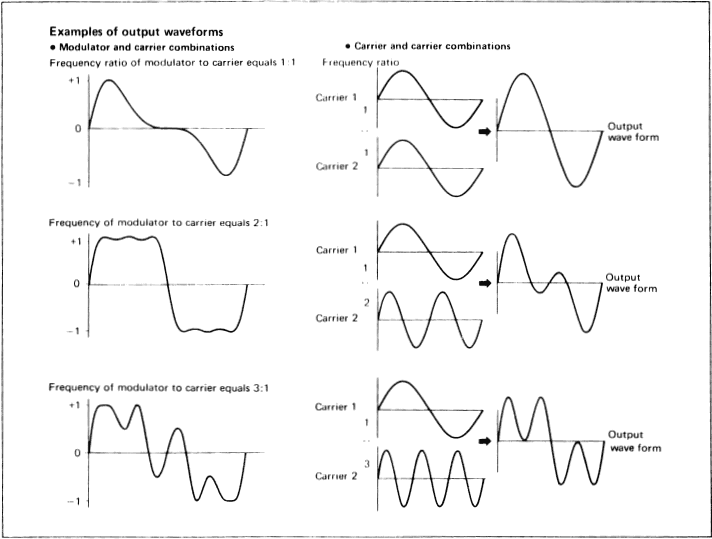
- Algorithms . . . . Combining Several Operators
The DX7 has a total of six operators. The way in which these operators are combined is known*/ as an "algorithm." The DX7 has 32 different pre-programmed algorithms. The 32 algorithms are displayed graphically along the top of the control panel above the selector keys. Taking algorithm number one as an example, the lowest two operators--1 and 3--are carriers. The four operators above the carriers will function as modulators. The output of operator 6 is fed back (feedback) to its input.
The above is a brief description of the internal workings of the FM tone generator system. By varying the pitch frequency, modulation and envelope data it is possible to edit pre-programmed voices or to create entirely new voices.
